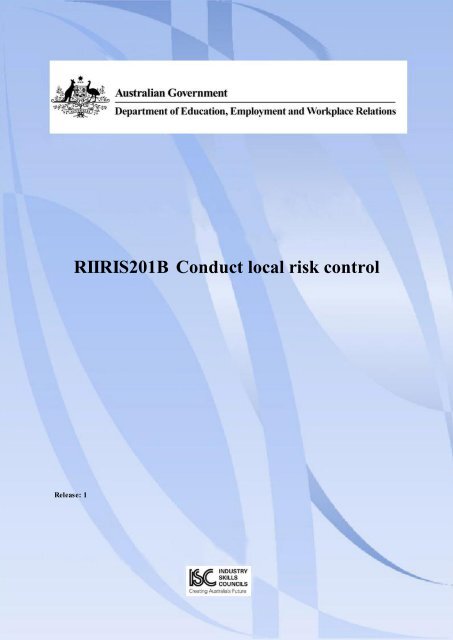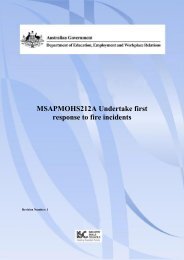RIIRIS201B Conduct local risk control
RIIRIS201B Conduct local risk control - Mines Rescue
RIIRIS201B Conduct local risk control - Mines Rescue
Create successful ePaper yourself
Turn your PDF publications into a flip-book with our unique Google optimized e-Paper software.
Release: 1<strong>RIIRIS201B</strong> <strong>Conduct</strong> <strong>local</strong> <strong>risk</strong> <strong>control</strong>
<strong>RIIRIS201B</strong> <strong>Conduct</strong> <strong>local</strong> <strong>risk</strong> <strong>control</strong> Date this document was generated: 12 January 2012<strong>RIIRIS201B</strong> <strong>Conduct</strong> <strong>local</strong> <strong>risk</strong> <strong>control</strong>Modification HistoryNot applicable.Unit DescriptorThis unit covers the conduct of <strong>local</strong> <strong>risk</strong> <strong>control</strong> in resources and infrastructure industries. Itincludes identifying hazards; assessing <strong>risk</strong> and identifying unacceptable <strong>risk</strong>; identifying,assessing and implementing <strong>risk</strong> treatments; and completing records and reports.Application of the UnitThis unit is appropriate for those working in entry level operational roles, at worksites within:Civil constructionCoal miningDrillingExtractive industriesMetalliferous miningLicensing/Regulatory InformationRefer to Unit Descriptor.Pre-RequisitesNot applicable.Employability Skills InformationThis unit contains employability skills.Elements and Performance Criteria Pre-ContentElements describe theessential outcomes of aunit of competency.Performance criteria describe the performance needed todemonstrate achievement of the element. Where bolditalicised text is used, further information is detailed in therequired skills and knowledge section and the rangestatement. Assessment of performance is to be consistentwith the evidence guide.Approved Page 2 of 8© Commonwealth of Australia, 2012 SkillsDMC
<strong>RIIRIS201B</strong> <strong>Conduct</strong> <strong>local</strong> <strong>risk</strong> <strong>control</strong> Date this document was generated: 12 January 2012Elements and Performance CriteriaELEMENTPERFORMANCE CRITERIA1. Identify hazards 1.1. Access, interpret and apply compliancedocumentation relevant to conducting <strong>local</strong><strong>risk</strong> <strong>control</strong>1.2. Inspect work area conditions to identifypotential hazards in the workplace1.3. Apply existing procedures to deal withrecognised hazards1.4. Recognise the type and scope ofunresolved hazards and their likely impact2. Assess <strong>risk</strong> and identifyunacceptable <strong>risk</strong>3. Identify, assess and implement<strong>risk</strong> treatments2.1. Assess and determine consequence if theevent should occur2.2. Consider and determine likelihood of theevent2.3. Identify criteria for theacceptability/unacceptability of the <strong>risk</strong> orsource from the appropriate party2.4. Assess <strong>risk</strong> against criteria to identify if itwarrants 'unacceptable <strong>risk</strong>' status andeither action or refer to the appropriateparty3.1. Identify and consider all possible <strong>risk</strong>treatment options3.2. Identify options by preliminary analysisand consideration of possible options3.3. Analyse options, including theidentification of resource requirements3.4. Select most appropriate action for dealingwith the situation3.5. Plan and prepare the course of action indetail and acquire/obtain required resources3.6. Implement the <strong>risk</strong> treatment3.7. Review <strong>risk</strong> management processes4. Complete records and reports 4.1. Communicate information on the course ofaction and implementation4.2. Complete records and reports for hazardsand actions from personal <strong>risk</strong> assessmentas specified by legislation and siterequirementsApproved Page 3 of 8© Commonwealth of Australia, 2012 SkillsDMC
<strong>RIIRIS201B</strong> <strong>Conduct</strong> <strong>local</strong> <strong>risk</strong> <strong>control</strong> Date this document was generated: 12 January 2012Required Skills and KnowledgeThis section describes the skills and knowledge required for this unit.Required skillsSpecific skills are required to achieve the performance criteria in this unit, particularlyfor the application in the various circumstances in which this unit may be applied. Thisincludes the ability to carry out the following as required to conduct <strong>local</strong> <strong>risk</strong> <strong>control</strong>:apply legislative, organisation and site requirements and proceduresspeak clearly and directly, listen carefully to instructions and information, respondto and clarify directionscollect, analyse and organise informationaccess, interpret and apply site informationwork with other team membersapply teamwork to a range of situationsapply problems solving skillsapply decision making skillsshow initiative in adapting to changing work conditions or contextsapply time managementtake responsibility for self organisation of work prioritiesapply mathematical skills to perform a basic <strong>risk</strong> ranking of hazardsinterpret and apply material safety data sheets (MSDS)Required knowledgeSpecific knowledge is required to achieve the performance criteria of this unit,particularly its application in a variety of circumstances in which the unit may be used.This includes knowledge of the following as required to conduct <strong>local</strong> <strong>risk</strong> <strong>control</strong>:<strong>risk</strong> management processes and methods, including: identifying hazards, assessing<strong>risk</strong>s, determining acceptability of <strong>risk</strong>s, identifying <strong>control</strong>sAS/NZS 4360-2004 Risk Managementspecific worksite <strong>risk</strong> management proceduresspecific worksite safety systems informationspecific worksite communication, reporting and recording proceduresApproved Page 4 of 8© Commonwealth of Australia, 2012 SkillsDMC
<strong>RIIRIS201B</strong> <strong>Conduct</strong> <strong>local</strong> <strong>risk</strong> <strong>control</strong> Date this document was generated: 12 January 2012Evidence GuideThe evidence guide provides advice on assessment and must be read in conjunctionwith the performance criteria, required skills and knowledge, range statement and theAssessment Guidelines for the Training Package.Overview of assessmentCritical aspects for assessmentand evidence required todemonstrate competency in thisunitContext of and specificresources for assessmentThe evidence required to demonstrate competencyin this unit must be relevant to worksite operationsand satisfy all of the requirements of theperformance criteria, required skills andknowledge and the range statement of this unit andinclude evidence of the following:knowledge of the requirements, procedures andinstructions to conduct <strong>local</strong> <strong>risk</strong> <strong>control</strong>implementation of requirements, proceduresand techniques for the safe, effective andefficient conduct of <strong>local</strong> <strong>risk</strong> <strong>control</strong>working with others to undertake and conductof <strong>local</strong> <strong>risk</strong> <strong>control</strong> that meets all of therequired outcomesconsistent timely completion of conducting<strong>local</strong> <strong>risk</strong> <strong>control</strong> that safely, effectively andefficiently meets the required outcomesThis unit must be assessed in the context of thework environment. Where personal safety orenvironmental damage are limiting factors,assessment may occur in a simulatedenvironment provided it is realistic andsufficiently rigorous to cover all aspects ofworkplace performance, including task skills,task management skills, contingencymanagement skills and job role environmentskills.The assessment environment should notdisadvantage the participant. For example,language, literacy and numeracy demands ofassessment should not be greater than thoserequired on the job.Customisation of assessment and deliveryenvironment to sensitively accommodatecultural diversity.Aboriginal people and other people from a nonEnglish speaking background may have secondlanguage issues.Approved Page 5 of 8© Commonwealth of Australia, 2012 SkillsDMC
<strong>RIIRIS201B</strong> <strong>Conduct</strong> <strong>local</strong> <strong>risk</strong> <strong>control</strong> Date this document was generated: 12 January 2012Method of assessmentGuidance information forassessmentAssessment of this competency requires typicalresources normally used in the workenvironment. Selection and use of resources forparticular worksites may differ due to sitecircumstances.Where applicable, physical resources shouldinclude equipment modified for people withdisabilities.Access must be provided to appropriatelearning and/or assessment support whenrequired.This unit may be assessed in a holistic way withother units of competency. The assessment strategyfor this unit must verify required knowledge andskill and practical application using more than oneof the following assessment methods:written and/or oral assessment of thecandidate's required knowledgeobserved, documented and/or first handtestimonial evidence of the candidate's: implementation of appropriate requirement,procedures and techniques for the safe,effective and efficient achievement ofrequired outcomes consistently achieving the requiredoutcomesfirst hand testimonial evidence of thecandidate's: working with others to undertake andconduct of <strong>local</strong> <strong>risk</strong> <strong>control</strong>Consult the SkillsDMC User Guide for furtherinformation on assessment including access andequity issues.Approved Page 6 of 8© Commonwealth of Australia, 2012 SkillsDMC
<strong>RIIRIS201B</strong> <strong>Conduct</strong> <strong>local</strong> <strong>risk</strong> <strong>control</strong> Date this document was generated: 12 January 2012Range StatementThe range statement relates to the unit of competency as a whole. It allows for differentwork environments and situations that may affect performance. Bold italicisedwording, if used in the performance criteria, is detailed below. Essential operatingconditions that may be present with training and assessment (depending on the worksituation, needs of the candidate, accessibility of the item, and <strong>local</strong> industry andregional contexts) may also be included.Relevant compliancedocumentation may include:legislative, organisation and site requirementsand proceduresAustralian standardscode of practiceEmployment and Workplace RelationslegislationEqual Employment Opportunity and DisabilityDiscrimination legislationHazard is defined as: a source of potential harm or a situation with apotential to cause lossHazards may include: equipment stored energy methods plans people the work environmentRisk is defined as: The chance of something happening that willhave an impact upon objectives. It is measuredin terms of consequences and likelihoodRisk treatment is defined as: selection and implementation of appropriateoptions for dealing with <strong>risk</strong>Consequence is defined as: the outcome of an event or situation expressedqualitatively or quantitatively, being a loss,injury, disadvantage or gainFrequency is defined as: a measure of likelihood expressed as thenumber of occurrences of an event in a giventimeLikelihood is used as: a qualitative description of probability andfrequencyProbability is defined as: the measure of the chance of occurrenceexpressed as a number between 0 and 1Criteria for the acceptability/unacceptability of the <strong>risk</strong> mustbe determined by:the organisation's internal policy, goals and/ orobjectives in reference to relevant legislationApproved Page 7 of 8© Commonwealth of Australia, 2012 SkillsDMC
<strong>RIIRIS201B</strong> <strong>Conduct</strong> <strong>local</strong> <strong>risk</strong> <strong>control</strong> Date this document was generated: 12 January 2012Risk treatmentoptions mayinclude:Records and reports mayinclude: eliminating the hazard substitution engineering <strong>control</strong>s administrative <strong>control</strong>s (procedures, etc) personal protective equipment. hazard reporting forms supervisor/deputy/OCE reports incident reports near miss reports shift reports JSAs Take 5 Step BackUnit Sector(s)Risk ManagementCompetency fieldRefer to Unit Sector(s).Co-requisite unitsNot applicable.Approved Page 8 of 8© Commonwealth of Australia, 2012 SkillsDMC




